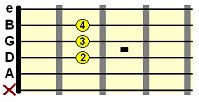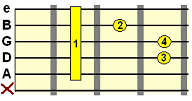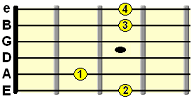Home
> Progressions
>
iii Chord
We've just built chords on each degree as opposed to playing them as single notes like the scales you use for lead soloing.
With the chord scale nearly complete, let's now add in the iii chord, known as the mediant in diatonic theory. Just think of it as the 3rd chord in the 7 chord scale we're building...
I ii iii IV V vi vii
Just like in the other lessons, I'll first go through the iii chord's position in relation to the tonic (I) and other chords in the scale, then we'll look at how we can use the iii chord in various combinations with the other chord positions we've learned.
Let's say our tonic chord was C major. Its related mediant iii chord would therefore be E minor (since E is the third note of C major). We'll look at exactly how we work this out in more detail in a minute, but first I just want you to get a taste of the sound of this interval...
I iii Click to hear
What's interesting about the iii chord is it's rarely used in the above way, to resolve straight back to the tonic chord. It has more of a tendancy to lead either up to the IV chord, fall to the ii chord or move to the vi chord. It is therefore used more as a link to other chords on a journey away from the tonic. For example (using C major as our tonic again)...
I iii IV Click to hear
I iii vi V Click to hear
We'll look at common uses of the 3 chord later.
Note that the 1st diagram slightly overlaps the next...


In both examples, look at where the iii chord appears in relation to other chords in the scale. Try and memorise these relationships. For example...
This is the most basic way to understand the relationship between chords in a scale, since once you know the root note intervals between them, you can start to build chords around those same intervals.
A few points:
I iii ii V click to hear
ii iii ii I click to hear
I iii vi IV click to hear
As usual, experiment with your own combinations and don't forget to try modifications of chords that we've looked at in previous lessons, such as minor iv chords. There's more and more to think about as our creative options expand, but that's good! Keep referring to past lessons to refresh your memory.
Mediant Variation
Main Guitar Chord Progressions Section
Using the Mediant iii Chord in Chord Progressions
Over the past lessons, we've been building the diatonic chord scale - a naturally occuring system of chords built on the 7 degrees of the major scale.We've just built chords on each degree as opposed to playing them as single notes like the scales you use for lead soloing.
With the chord scale nearly complete, let's now add in the iii chord, known as the mediant in diatonic theory. Just think of it as the 3rd chord in the 7 chord scale we're building...
I ii iii IV V vi vii
Just like in the other lessons, I'll first go through the iii chord's position in relation to the tonic (I) and other chords in the scale, then we'll look at how we can use the iii chord in various combinations with the other chord positions we've learned.
Mediant iii chord function
The iii chord, as represented by the lower case numerals, is naturally a minor chord. The first thing we need to do is listen to how it interacts with its related tonic chord, no matter what key you're playing in.Let's say our tonic chord was C major. Its related mediant iii chord would therefore be E minor (since E is the third note of C major). We'll look at exactly how we work this out in more detail in a minute, but first I just want you to get a taste of the sound of this interval...
I iii Click to hear
What's interesting about the iii chord is it's rarely used in the above way, to resolve straight back to the tonic chord. It has more of a tendancy to lead either up to the IV chord, fall to the ii chord or move to the vi chord. It is therefore used more as a link to other chords on a journey away from the tonic. For example (using C major as our tonic again)...
I iii IV Click to hear
I iii vi V Click to hear
We'll look at common uses of the 3 chord later.
I ii iii IV V vi intervals
Let's see how the iii chord fits in to the chord interval pattern we've been building in past lessons. Remember, each of these positions (degrees) represents the root note from which we can build chords, whether barre or other movable shapes. More on chords types in the chord section of the site.Note that the 1st diagram slightly overlaps the next...


In both examples, look at where the iii chord appears in relation to other chords in the scale. Try and memorise these relationships. For example...
- iii appears one fret (one semitone) down from the IV chord on the same string.
- iii appears two frets up (one whole step) from the ii chord on the same string.
- With I on the E string, iii appears diagonally to the left on the next string up (two whole steps).
This is the most basic way to understand the relationship between chords in a scale, since once you know the root note intervals between them, you can start to build chords around those same intervals.
Chord progressions involving the iii chord
So now we have 6 chords from which we can draw various combinations (progressions). I know several songs that simply use I ii iii IV (or in reverse) as a straight sequence. I'm sure you can be more inventive than that! ;)A few points:
- Progressions don't always need to start on the tonic chord.
- You don't have to use the iii chord at all if you don't want to, but the option is there!
- These are all major key progressions (hence the capitalised I tonic). We'll look at minor key progressions another time.
I iii ii V click to hear
I - A major |
iii -
C# minor Fret 4 |
ii - B
minor Fret 2 |
V
- E |
ii iii ii I click to hear
ii - Abm7 Fret 4 |
iii -
Bbm7 Fret 6 |
ii - Abm7 Fret 4 |
I - F#
major Fret 2 |
I iii vi IV click to hear
I - D major |
iii -
F# minor Fret 2 |
vi - B minor Fret 2 |
IV - G
major |
As usual, experiment with your own combinations and don't forget to try modifications of chords that we've looked at in previous lessons, such as minor iv chords. There's more and more to think about as our creative options expand, but that's good! Keep referring to past lessons to refresh your memory.
| |
Tweet |
Stay updated and learn more
Sign up to the newsletter for updates and grab your free Uncommon Chords book
Sign up to the newsletter for updates and grab your free Uncommon Chords book
Related
Mediant Variation
Main Guitar Chord Progressions Section








